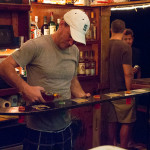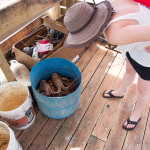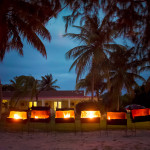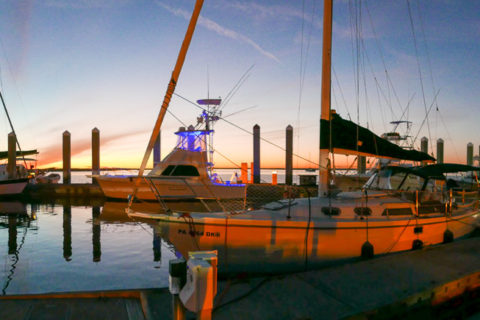We had such a great time on our first BVI charter, that we decided to take the same trip the next year. Hit some different stops this time, and made it up to Anegada. This time we were the old salts, showing the newbies around – although I learned a valuable lesson as well.
So most of the time in the BVIs we have picked up moorings for the simple convenience of it. On those big cats, the mooring procedure we use is thus:
- One person on the helm, one bowman with boat hook for grabbing the pennant. The helmsman motors up to the ball on one side or the other, guided by hand signals from the bowman
- Once the mooring ball is within reach, the bowman usually has to lie down flat on the deck in order to reach the pennant with the boat hook (high freeboard on those big cats!) at this point one of the other crew relays the bowman’s directions to the helm.
- Bowman grabs the pennant, threads a line from the cleat, through the pennant and back to the same cleat (running a line through the pennant from one cleat to the other is a big no-no as it can chafe through the line)
- Once the line is fastned back to the cleat, the bowman yells “made” and the helm puts it into neutral letting, letting the boat settle.
- Once it falls back, a second line is brought over from the other side cleat, threaded through the pennant, and returned to it’s cleat, forming the bridle. Both lines are then adjusted to center the ball, get the correct length of bridle etc… Pretty straightforward.
Now I was on the bow with the newer crew, showing them the mooring procedure. I had just picked up the pennant and gotten the first line through, when the boat hook got stuck in the pennant eye. Not wanting to lose it, I was trying to get the line cleated off at the same time as I tried to recover the hook, lying on my belly right at the tip of the bow. At which point, someone must have thought I had the line fully cleated off and yelled “made” back to the helm.
The only problem was the line *wasn’t* made!
As the helmsman put the engines in neutral, the wind/current immediately caught the boat and it began falling back. Bear in mind this is a 46′, 10 ton boat with a *lot* of windage. Both the mooring line and boat hook were jerked out of my hands. At this point I probably should have just aborted, pulled in the line and re-done the mooring, however the line was still though the pennant eye, the boat hook was still stuck and I was able to grab them both – somehow I managed to get the line cleated and recover the hook, and then I looked down to see the deck covered in blood.
Not just a few drops – covered.
My brain didn’t register at first, I didn’t realize what exactly I was looking at. I wasn’t in any pain, so I frantically began checking myself for injuries. Chest, hands, arms all fine. Then I realized that as I was lying face down when the boat jerked, something had torn a big flap of flesh off my knee. Fortunately it wasn’t anything serious, it just bled a lot. We had a good first aid kit on board and I was able to patch it up and bandage it without further ado. No lasting harm done. However the experience taught me a valuable sailing lesson, and that is:
Always make sure you have a clear, well established “chain of command” and signals for communicating back and forth with crew.
This was simply a case of “too many cooks in the kitchen” syndrome, with everyone calling out commands at once, too much communication made it impossible to know who to listen to. Always make sure the helm knows exactly who will be giving commands, and what signals and commands will be given. If I ever forget, I now have a sweet scar to remind me of this lesson!
Aside from that one incident, the trip was awesome. Much snorkeling was done, and much rum was consumed… We basically decided that the BVIs are pretty much our favorite place ever, although next time we go back it will hopefully be on our own boat and we won’t be limited to only a week or two!




































